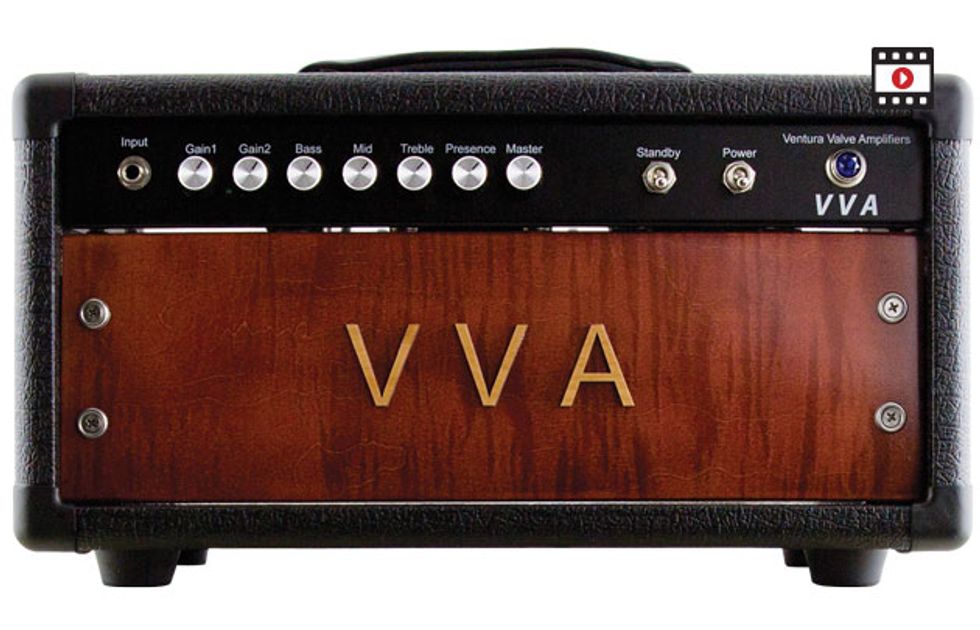Lately I’ve been reviewing a lot of ultra-high-end amps. While it’s a joy and a privilege to spend time with such beautiful instruments, it can feel like I’m writing the same article over and over: “Unbelievable tones. Unbelievable workmanship. Unbelievable $3,200 price tag.”
So it’s a treat to uncover a versatile boutique head with many fine tones and a vibey handmade feel that sells for a sensible $1,299.
Tough Transformers
Powered by a pair of big 6L6-GC tubes, Ventura Valve Amps’ VVA50 is a descendant of such classic mid-sized Fender amps as the Bandmaster, Super, and Bassman. But it’s no clone—with its multiple cascading gain stages, it’s more like a vintage ’60s Fender hot-rodded by some crafty amp tech at some point in the ’70s. (Ventura Valve Amps also makes a more “British” version of the head with EL-34 power tubes.)
Naturally, the parts and workmanship aren’t identical to what you tend to encounter in amps selling for more than twice the price, but the VVA50 cuts costs in intelligent ways. Internal components are assembled on a modern circuit board, substantially reducing assembly time and cost. There are no magic unicorns inside: just standard-issue modern parts, including plastic tube sockets and CDM capacitors.
but relatively loose lows.
Instead, Ventura invests their resources where they really count: the VVA50 houses a honkin’ pair of Mercury Magnetics transformers—real top-drawer stuff. The amp’s guts reside in an aluminum chassis secured by four long bolts. (Removing the chassis takes 5 minutes, max’.) The wiring work is solid, if not virtuosic. There are a few needlessly long wire runs, but there’s nothing to suggest the amp won’t perform reliably for many years.
Despite some large parts, the VVA50 head resides in a compact 17"x9"x8" solid-wood cabinet, weighing in at a manageable 29 pounds. Our review model was covered in Tolex, with a rugged carrying handle. (Ventura offers a wood-covered model for $100 extra.)
It’s a single-channel design, with just one input jack and one speaker out (switchable between 4, 8, and 16 ohms). But even if you’re a player who relies on a hot gain channel for solos, you’re covered: You can switch to high-gain mode via footswitch (included) or a rear-panel button. The front panel includes bass, mid, treble, and presence controls, master volume, and two additional gain controls. Our demo amp came stocked with fine-sounding JJ power tubes, and JJ and EHX preamp tubes. Its rectifier is solid-state.
To record the demo clips, I connected the VVA50 to a THD “Mickey Mouse” cabinet with one 12" and two 10" speakers, miking one of the 10s with a Royer R-121 ribbon mic. The demo guitar is a Les Paul with unpotted PAF-style pickups.
Ratings
Pros:
Sparkling clean tones. Many flavors of crunch. Solid build. Reasonable price.
Cons:
Only one channel/input. No reverb or tremolo.
Tones:
Ease of Use:
Build/Design:
Value:
Street:
$1,299 street (as reviewed with Tolex covering—wood finish $100 extra)
Ventura Valve Amps VVA50
vvamps.com
The Gain Game
Between the dual gain knobs, the gain switch, and the master volume, you can dial in a vast range of sounds without ever touching the tone controls. Clean settings are crisp and articulate in classic Fender fashion, with glistening highs, speedy response, and lots of airy headroom. Note fundamentals feel deep and grounded, with superb sustain even at super-clean settings. Distortion gradually accumulates as you advance either or both gain controls, but not too much or too soon—there are cool and usable semi-driven colors throughout the knobs’ range. The two gain stages provide dramatic tone contrasts: Settings that emphasize gain 1 tend to break up in a loose, spattery sort of way, while those emphasizing gain 2 are tighter and brighter.
When both knobs are cranked, you get singing, harmonically rich sustain. But it’s not the sort of hyper-saturated grind you expect from modern metal and hard rock amps. Even here, there’s crisp note attack and excellent dynamic response. You can floor both gain controls and still get nice clean sounds by backing off your guitar’s volume. Maximum-crunch tones are closer to ’70s classic rock than modern “chunk” tones, with explosive harmonics but relatively loose lows. Actually, dialing in high-gain tones feels a lot like working with a vintage Marshall with a jumper cable between its channels. (It’s worth remembering that early Marshalls were strongly “influenced” by dual 6L6 Fenders.)
And then there’s the boost circuit, which adds gobs of gain with little additional coloration. Engaging it feels a bit like whacking the amp’s input with a powerful clean boost pedal. It’s easy to imagine players getting every tone they need from the VVA50’s single-channel design: You might set the front-panel gain relatively high, veer from clean to crunch via touch and guitar settings, and then kick on the boost for loud solos or monster chords.
The Verdict
With tones ranging from Fender-like sparkle to plexi-colored crunch, Ventura Valve Amps’ VVA550 is an ultra-versatile head that can cover most styles short of full-on metal. With its fine dynamic response and highly interactive gain controls, it’s an uncommonly responsive amp as well. Regardless of gain settings, notes are well defined and harmonically rich, with powerful fundamentals, zingy highs, and relentless sustain. This amp could be a great choice for guitarists who covet a top-tier boutique head but can’t quite cough up the cash.
Watch the Review Demo:








![Rig Rundown: Russian Circles’ Mike Sullivan [2025]](https://www.premierguitar.com/media-library/youtube.jpg?id=62303631&width=1245&height=700&quality=70&coordinates=0%2C0%2C0%2C0)

















